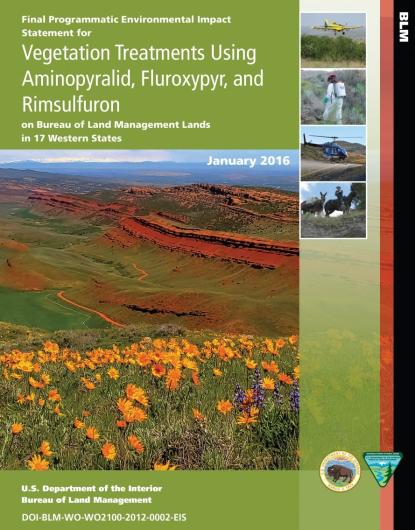VEGETATION PROGRAMMATIC ENVIRONMENTAL IMPACT STATEMENT
The BLM signed the Record of Decision for the Final Programmatic Environmental Impact Statement National Vegetation Treatments Using Aminopyralid, Fluroxypyr, and Rimsulfuron (Final Programmatic EIS) on BLM Lands administered lands on August 15, 2016. The Final Programmatic EIS provides a cumulative impact analysis addressing the use of chemical herbicides in conjunction with other treatment methods, addressing human health and ecological risks for the use of these three active ingredients (herbicides) on public lands. The 2016 Final Programmatic EIS includes an updated analysis per the National Environmental Policy Act (NEPA) compliance document on the effects of using herbicides for treating vegetation on public lands in the western U.S., including Alaska.
The Record of Decision outlines the approval for the use of three additional EPA registered herbicide active ingredients on all 17 states assessed in the Final Programmatic EIS: aminopyralid, fluroxypyr, and rimsulfuron. The Human Health and Ecological Risk Assessment prepared for the Final Programmatic EIS can be found on the Updated Risk Assessments Page. Also available are the two new risk assessment documents, for 2, 4-D and clopyralid, that provide the field offices updated information to be used in conjunction with their NEPA analysis when including the two active ingredients in their vegetation management plans.
The Final Programmatic EIS considered vegetation treatment activities, including noxious weed and invasive terrestrial plant species management, hazardous fuels reduction treatments, emergency stabilization and rehabilitation efforts. The Final Programmatic EIS tiers to the 2007 Final Vegetation Treatments Using Herbicides on the Bureau of Land Management Lands in 17 Western States PEIS (2007 Programmatic EIS) and the Programmatic Environmental Report.


